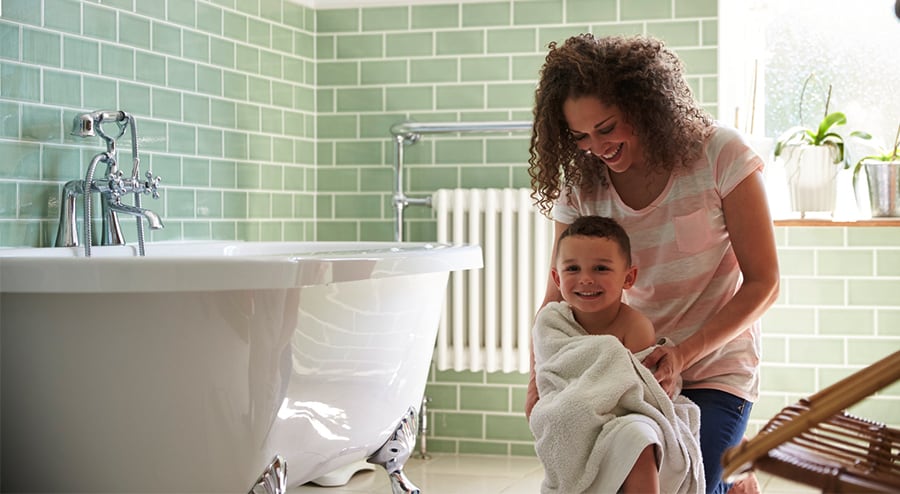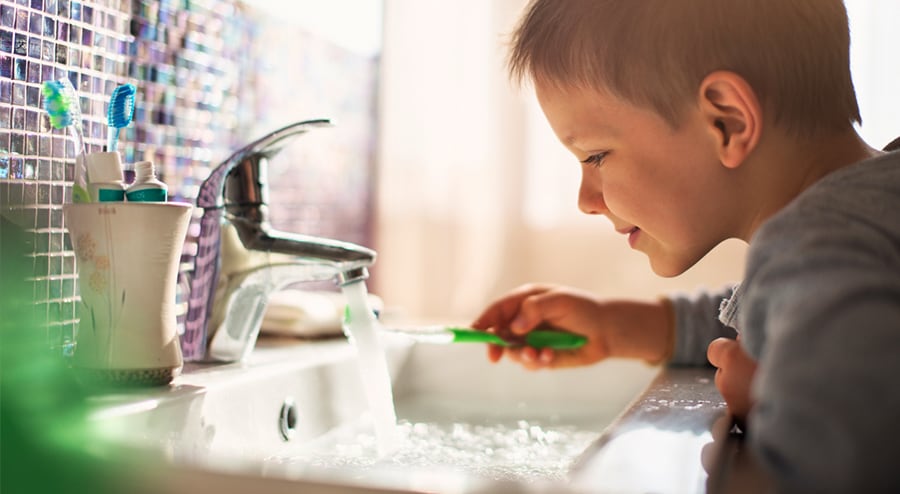With its obvious dangers—sharp utensils, hot appliances, and boiling water—people often think of the kitchen as the most dangerous room in the home. The dangers that lurk in the bathroom, on the other hand, are frequently overlooked, especially the risks that bathrooms pose for the youngest and oldest family members.
In a report released in 2011, however, the Centers for Disease Control and Prevention (CDC) estimated that nearly a quarter million people injured themselves in bathrooms in 2008, the last year for which they had data. That’s a high number, but these were only nonfatal injuries, and the estimate excluded children younger than 15. It’s possible that our bathrooms pose a even greater risk.
Fortunately, the CDC concluded that while bathrooms are “associated with a high risk of injury,” they also concluded that modifying the environment in the bathroom can reduce that risk. With that in mind, read on to find out about some of the bathroom’s biggest dangers, and get some suggestions for how to keep you and your household safe.
Keeping Your Bathroom Safe for Young Children
Young children require constant supervision in most areas of the home. They can find trouble in an instant in any room, but because of the presence of water, the bathroom is one of the most dangerous areas. From drowning to burns, water poses many risks.
Step 1: Actively Supervise Your Children in the Bathroom
It may be tempting to check your social media or to attend to another task while your children are bathing. Unfortunately, however, the Consumer Product Safety Commission lists drowning as the leading cause of unintentional death among children one to four years of age, and a young child can drown in just a few moments. Furthermore, drowning is silent, with no warning sounds to draw your attention. If you are not actively supervising your children in the bathtub, drowning is a serious risk
Step 2: Check the Water Temperature
Nothing feels better than a long, hot shower, but hot water poses a significant risk to young children. Water at 140º F can scald skin in less than five seconds, and the skin of young children can burn quickly even at lower temperatures.
To protect your children from burns in the bathroom:
- Lower the temperature setting on your water heater. Young children may turn on the hot water when you aren’t around, and so a lower temperature setting can protect them from accidental scalding. A recommended setting for the hot water heater is 120º F.
- Fill the bathtub prior to placing your child in the bath to allow the water temperature to even out.
- Use a thermometer to measure bath water temperature. What seems a comfortable temperature for you is probably too hot for your child, so make sure your bath water never exceeds 100º F.

Step 3: Install Safety Devices
Take a look around your bathroom and consider whether or not the following environmental changes would enhance the safety of your family’s bathroom:
- Locks or covers to prevent your child from intentionally or accidentally turning on the taps in the bath, or the hot water tap at the sink
- A safety latch to keep toddlers out of the toilet
- A small stool to allow young children to easily reach the sink
- A LED night light that turns on automatically when the lights are off
- Cabinet latches or safety devices on closet doors where bathroom chemicals or medications are stored
Keep in mind that childproofing is an ongoing process. As children grow and become mobile and curious, different levels of childproofing will be necessary. Anticipating problems before they occur is a great way to keep children safe.
Bathroom Safety for the Elderly
Just as with children, the bathroom presents a unique set of challenges for the elderly, especially those who have limited mobility due to arthritis, injury, or age. Reduced mobility can make simple tasks more difficult and can lead to delayed reactions in a time of danger. If you or a family member is getting older, consider the following steps to ensure bathroom safety:
- Install grab bars. These bars, anchored into the wall, provide stability as you exit the shower or get up from the toilet.
- Install a higher commode. Some toilets sit low to the ground. A toilet with a greater height is easier to get up from. More elderly individuals sustain injuries from sitting down on or getting up from the toilet than they do from the bathtub.
- Install a new tub and/or shower. Stepping up into a tub or shower can be problematic for the elderly. A walk-in tub or shower can make the task of bathing much easier and safer.
- Use a shower chair. Specially designed chairs for the shower allow you to sit while showering. Even if a person stands, the chair can provide stability.
- Eliminate obstacles. Throw rugs are pretty and can liven up any space, but they may pose a tripping hazard or accessibility obstacles for the elderly.
Some of the safety tips for children are also applicable for the elderly. Extremely hot water and dark rooms pose risks for people of every age.
General Safety Tips for the Bathroom
How safe is your bathroom? Take a few moments to look at your bathrooms critically. Ask yourself the following questions.
- Are all electrical devices out of the reach of water?
- Does your bathroom have GFCI outlets that will shut off power to an appliance that falls in the water?
- Is the area well-lit?
- Do you use bath oils? Does this present a safety hazard for you or other members of your family?
- Can your family members and visitors safely access the bathroom?
- Can those who are unfamiliar with the room find the light switches?
- Are the rugs all non-slip with a rubberized backing to prevent falls?
- Do you have a shower mat in the tub to prevent slips?
- Are necessary shower items such as shampoo and soap easily accessible from the shower?
When it comes to the bathroom, simple changes in behavior and setup can greatly reduce the risk of injury. Being aware of problem spots and potential hazards and taking proactive steps to address these hazards will go a long way toward keeping you and your family safe


